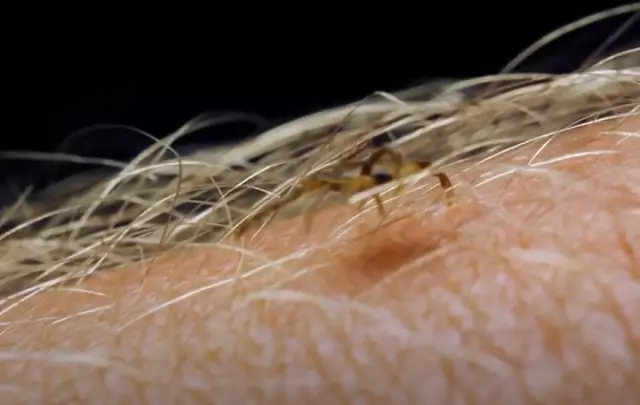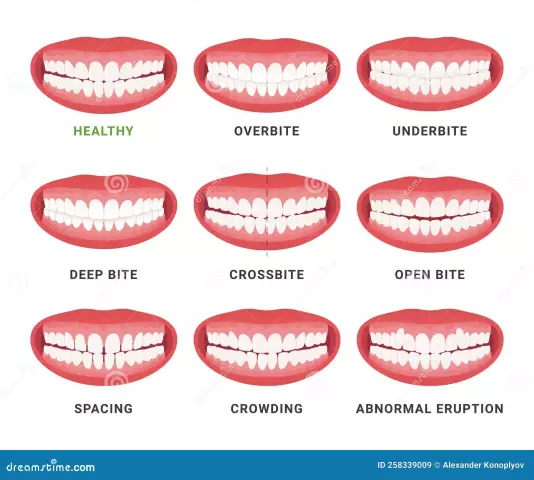- Author Rachel Wainwright [email protected].
- Public 2023-12-15 07:39.
- Last modified 2025-11-02 20:14.
First aid for a snake bite

Poisonous snakes are found everywhere, however, human contact with them is rare enough. Even less often, snakes attack people and bite them, although this happens. Fortunately, in our area there are practically no snakes whose bite would be certainly fatal, nevertheless, such a meeting cannot be ruled out, and in addition, even a not too strong snake venom can cause a severe reaction in people with hypersensitivity.
Snake toxin, even in non-lethal concentrations, can cause severe local and general reactions, so it is necessary to know how to provide first aid for snake bites - before the victim is taken to the hospital.
What to do if bitten by a snake

Most often, we have to deal with non-venomous snakes, so if a person is bitten by a snake, we should try to soberly assess what happened. If after the bite there is no rapid deterioration of the general condition, the bitten part of the body does not swell, does not change its color, and the pain from the bite passes quickly, then most likely the snake was not poisonous. In this case, it is enough to treat the wound with an antiseptic.
If, after the bite, local and general changes begin to occur, you should act quickly, but at the same time do not fuss and prevent unnecessary movements of the victim - the fact is that the snake venom, once in the body, spreads through the blood and lymphatic vessels, and muscle contraction increases blood and lymph circulation, thereby quickly spreading the poison throughout the body.
So, first aid for a snake bite is as follows:
- Stop contact with the snake as soon as possible. If the snake grabbed a person and does not let go, it is necessary to unhook it, because the longer the bite lasts, the more poison will enter the body. It is advisable to have time to consider the snake in order to be able to describe it - this will help to subsequently choose the optimal treatment;
- After the bite, the victim must be immobilized (for the reason described above). If there are rescuers next to the victim, the person should be laid down with their legs slightly raised so that they are above the head. If at the time of the bite there was no one nearby, you should at least immobilize the affected part of the body (most often it is an arm or a leg);
- Remove all jewelry from the victim and loosen tight fasteners. This must be done so that the developing edema does not lead to traumatic compression of tissues;
- Apply a tight bandage to the affected body part above the bite site. An indication that the bandage is correctly applied is the ability to move between the bandage and the skin of two fingers. Too tight a bandage that does not allow this will cause circulatory disorders at the site of the bite, which in the future can lead to gangrene with a high degree of probability;
- It is necessary to intensively suck the poison out of the wound for 10-15 minutes. To do this, it is permissible to make one or two small incisions in the skin at the site of the bite to facilitate the removal of the toxin. The poison that got into the oral cavity is ten times less dangerous than that that got into the bloodstream, therefore it is only necessary that the rescuer sucking out the poison has no damage to the oral mucosa. However, the contents should not be swallowed and must be spit out. If you start doing this quickly and vigorously enough, you can remove up to 50% of the snake venom caught during the bite;
- One of the important first aid measures for a snakebite is the intake of fluid into the body. The victim should be offered water or any other drinks, except alcoholic ones. Drinking plenty of water will reduce the concentration of the poison;
- If the victim's condition is rapidly deteriorating, he loses consciousness, breathing and cardiac activity stops, resuscitation should be started (chest compressions, mouth-to-mouth artificial respiration, mouth-to-nose);
- Take the victim to the hospital as soon as possible, where he can be injected with antitoxic serum. In this case, it is advisable to transport a person in a lying position on a stretcher, if a child has suffered from a snake bite, he can be carried in his arms.
It should be remembered that antitoxic serum, which destroys snake venom that has entered the bloodstream, is most effective in the first 30-60 minutes after the bite, therefore it is important that the victim gets to a medical facility as early as possible, preferably within an hour after the bite.
What is forbidden to do when bitten by poisonous snakes
Sometimes, sincerely wanting to help, rescuers take actions that, instead of relief, further aggravate the victim's condition. Therefore, you should know what is categorically not recommended to do during first aid for a snake bite.
So, for poisonous snake bites, it is prohibited:
- Give the victim alcoholic (including low alcohol) drinks;
- Apply a tourniquet instead of a pressure bandage, as this will lead to tissue necrosis, as a result of which, in addition to the snake's venom, toxic products of tissue decay will also enter the bloodstream;
- Cauterize the bite with something (including solutions of a cauterizing action);
- Influence the affected area thermally - it is forbidden to apply both warming compresses and dressings, and cooling. The maximum allowable is cooling directly to the bite zone itself, in order to slow down the local blood circulation.
Preventing snake bites
In our area, venomous snakes are rarely found in densely populated areas. As a rule, human contact with a snake occurs away from city noise, on camping trips, country trips, etc. Therefore, when going on a trip or out of town, you should consider the possibility of such a meeting. If there is information that poisonous snakes are found in the area of residence, you should move there in clothes that leave as few open areas of the body as possible (long trousers, a jacket with long sleeves, high rubber boots, etc.). If you are planning a long journey, you should take a polyvalent antitoxic serum with you - it is an antidote to the toxins of most venomous snakes. On long hikes, this serum should always be with you within half an hour's reach.
Found a mistake in the text? Select it and press Ctrl + Enter.






